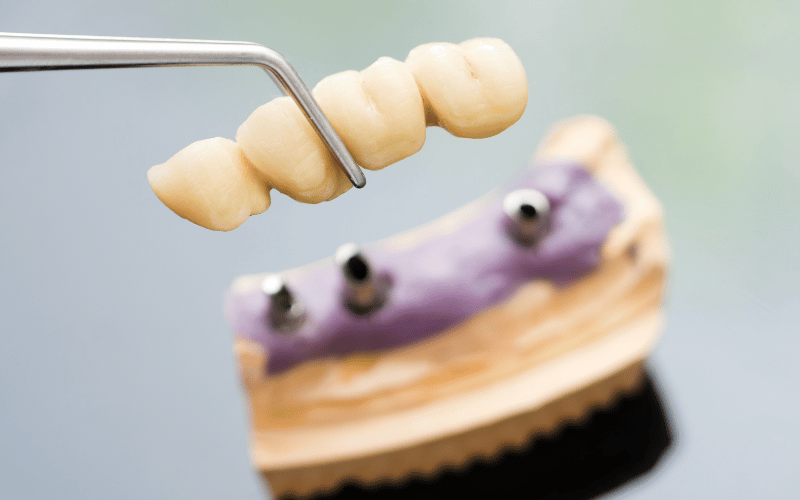
By West Albany Dental
Losing a tooth is not just about aesthetics. It can impact your oral health and daily life. Imagine struggling with chewing or feeling self-conscious about your smile every day. Missing teeth can also lead to further dental issues, like misalignment or gum disease. So, what is the solution? This blog explores whether a dental bridge is a good option for a missing tooth. It will dive into how dental bridges work, their benefits, and the latest advancements in bridge technology. Understanding your options is crucial for maintaining both your oral health and confidence.
What is a Dental Bridge?
A prosthetic device called a dental bridge is used to bridge the space left by a lost tooth. It “bridges” the space by anchoring to the adjacent teeth or dental implants. Dental bridges provide a workable remedy for tooth loss by restoring the appearance and functionality of your teeth.
Dental bridges can be made in many different ways, each intended to fulfill a particular purpose:
- Traditional Bridge: The most popular kind is a traditional bridge. It is made up of dental crowns on the teeth next to the gap holding a prosthetic tooth (pontic) in place.
- Cantilever Bridge: Used when there is only one adjacent tooth to anchor the bridge. This type is less common and generally used in less demanding areas, like the front teeth.
- Maryland Bridge: A porcelain or metal framework is cemented to the back of the neighboring teeth in this bridge. It requires less modification of the surrounding teeth but may not be as strong.
- Implant-Supported Bridge: Instead of being anchored to natural teeth, this bridge is supported by dental implants. It is a durable option, particularly for patients missing several teeth in a row.
How Do Dental Bridges Work?
The initial step in receiving a dental bridge is usually a consultation and evaluation. Your dentist will examine your teeth, obtain X-rays, and go over your best options. If a bridge is suitable, the next step is to prepare the adjacent teeth. This involves reshaping them to fit the crowns that will hold the bridge in place.
After preparation, your dentist takes an impression of your teeth. This mold is used to create a custom bridge that fits perfectly in your mouth. The bridge is crafted in a dental lab, usually taking a couple of weeks. Your exposed teeth and gums may be shielded in the interim with a temporary bridge.
Your dentist will fit and modify your permanent bridge to guarantee a proper bite once it is ready. The bridge is then cemented into place. With proper care, a dental bridge can successfully and steadily replace a lost tooth for many years.
Benefits of Choosing Dental Bridges
Restoration of Functionality
It might be challenging to chew food correctly when a tooth is missing, which could cause digestive problems. It can also affect your speech, as teeth play a crucial role in articulation. A dental bridge restores these functions by filling the gap left by the missing tooth. This allows you to eat comfortably and speak clearly, improving your quality of life.
Aesthetic Improvement
A lost tooth can leave a significant gap that affects the appearance of your face and smile. A dental bridge fills this gap, helping to restore your smile to its natural look. These days, dental bridges are almost indistinguishable from your original teeth because of their ability to mimic their color and structure. This improvement in appearance can boost your self-esteem and confidence, allowing you to smile freely.
Maintaining Oral Health
The neighboring teeth may begin to move toward the empty space after a tooth is lost, causing misalignment. This can cause bite issues and further complications, like temporomandibular joint (TMJ) disorders. A dental bridge prevents this by holding the adjacent teeth in place.
By maintaining the alignment of your teeth, a bridge contributes to overall oral health. Additionally, filling the gap can reduce the risk of gum disease and decay, as food particles are less likely to get trapped in the empty space.
Advancements in Dental Bridge Technology
Modern Materials and Techniques
Recent advancements in dental materials have significantly improved the durability and aesthetics of dental bridges. Zirconia and ceramic are now commonly used in bridge construction.
These materials are strong and resistant to wear, ensuring long-lasting results. They also offer a natural appearance, closely mimicking the look of real teeth.
Zirconia, in particular, is favored for its strength and translucency, making it ideal for both front and back teeth.
3D Printing and Customization
The advent of 3D printing in dentistry has revolutionized the creation of dental bridges in Albany. This technology allows for precise customization, ensuring that each bridge fits perfectly. The use of 3D imaging and printing technology also speeds up the process, reducing the time patients need to wait for their permanent bridge.
Additionally, 3D printing allows for more detailed and accurate designs, resulting in bridges that are not only functional but also aesthetically pleasing.
Consulting with Your Dentist
Importance of Professional Advice
Making the decision to have a dental bridge is not something you should do hastily. It is essential to consult with a dentist to get personalized advice.
Based on your unique needs, a dentist can evaluate your oral health and decide if a bridge is the right option for you. They can also explain the benefits and potential drawbacks, helping you make an informed decision.
What to Expect During a Consultation?
During a dental consultation, your dentist will conduct a thorough examination of your mouth. This may entail getting 3D scans or X-rays to evaluate the condition of your gums and remaining teeth.
Your dentist will go over the many kinds of dental bridges that are available as well as other possible choices like dentures or implants. They will assist you select the best option by outlining the benefits and drawbacks of each.
Finally, your dentist will outline the steps involved in the procedure, from preparation to placement, so you know what to expect.
Dental bridges are a reliable and effective solution for missing teeth. They restore functionality, improve appearance, and help maintain oral health. With advancements in materials and technology, dental bridges have become more durable and aesthetically pleasing than ever.
However, it is crucial to consult with a dentist to determine if a bridge is the best option for you. Professional advice is key to making the right choice. Do not let a missing tooth affect your life. Schedule a consultation today to explore your options and take the first step toward restoring your smile.





